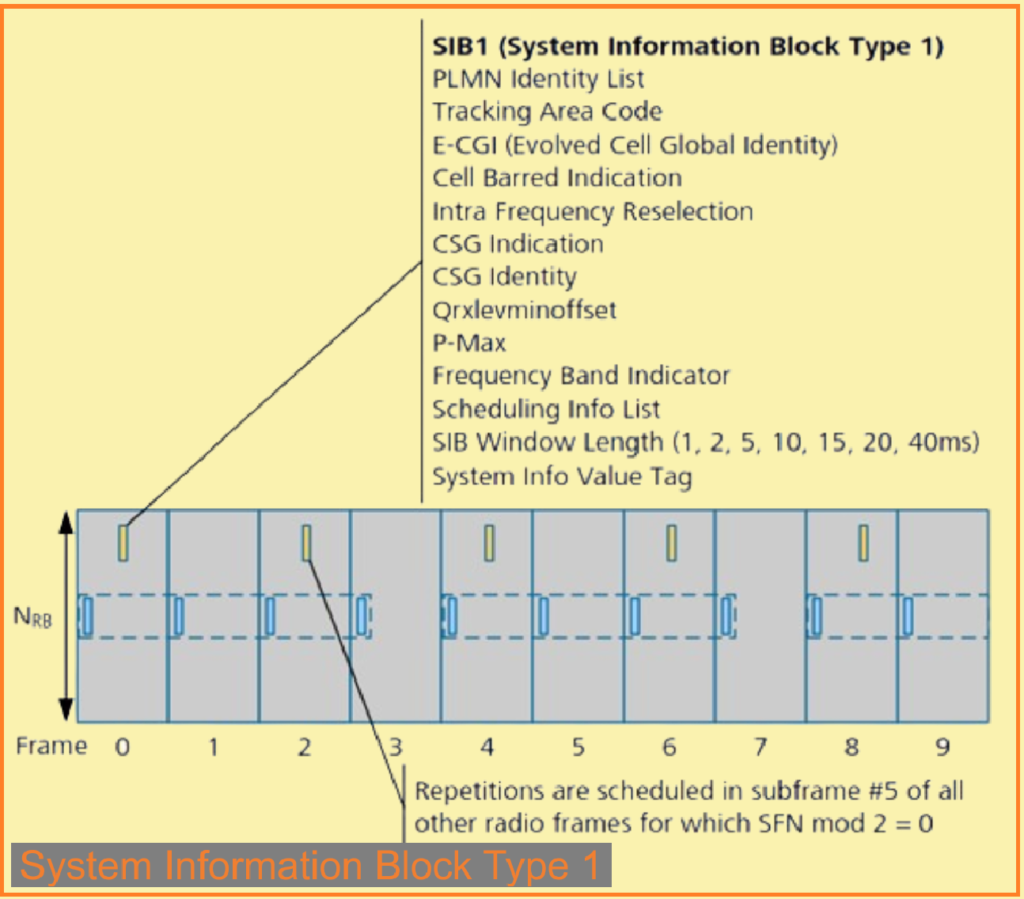The Master Information Block (MIB) sends only limited system information. Therefore, additional System Information Block (SIB) messages are needed. SIBs, except for SIB 1 (System Information Block Type 1), are included in System Information messages, which are transmitted on the Downlink Shared Channel (DL-SCH) based on various system parameters. SIB 1 is different because it has specific rules on how it must be sent.
LTE SIB1 (System Information Block Type 1).
System Information Block Type 1 (SIB1) contains key information about the cell and network. It also defines the scheduling window for other System Information messages. SIB1 is transmitted on subframe 5 when SFN mod 8=0 and repeated in subframe 5 when SFN mod 2=0.

The main information in SIB1 includes:
- PLMN Identity List: A list of PLMN identities, with the first listed being the primary PLMN.
- Tracking Area Code (TAC): A code common for all the PLMNs listed.
- E-CGI: A 28-bit cell identifier.
- Cell Barred Indication: Indicates whether the cell is barred.
- Intra-Frequency Reselection: Controls cell reselection to intra-frequency cells when the highest ranked cell is barred or treated as barred by the UE.
- CSG Indication: If set to “TRUE”, the UE CSG identity needs to match.
- CSG Identity: The identity of the Closed Subscriber Group within the primary PLMN the cell belongs to.
- Qrxlevminoffset: Affects the minimum required Rx level in the cell.
- P-Max: Part of the cell selection process.
- Frequency Band Indicator: Indicates the frequency band.
- SI Periodicity Mapping Information: Denotes a value in radio frames used to calculate the occurrence of messages.
- SIB Window Length: Indicates the scheduling window for all SIBs and can be 1, 2, 5, 10, 15, 20, or 40ms.
- System Info Value Tag: Common for all SIBs other than MIB, SIB1, SIB10, and SIB11.
Acquisition of an SI Message.
When acquiring an SI message, the UE performs various calculations to determine the start of the SI-window for the concerned SI message:
- For the concerned SI message, determine the number ( n ) which corresponds to the order of entry in the list of SI messages configured by “schedulingInfoList” in SIB1.
- Determine the integer value ( x = (n – 1) * w ), where ( w ) is the si-WindowLength.
- The SI-window starts at subframe (#a ), where a = x mod 10, in the radio frame for which SFN mod T = FLOOR (x/10), where ( T ) is the si-Periodicity of the concerned SI message.

The UE identifies the scheduling of SI messages by looking for the SI-RNTI (System Information – Radio Network Temporary Identifier) on the PDCCH.
LTE SIB2 (System Information Block Type 2).
System Information Block Type 2 (SIB2) contains radio resource configuration information that is common for all UEs. This includes detailed information on the access channels and paging channels.
LTE SIB2 includes:
- Access Class Information.
- Uplink Carrier Frequency.
- Uplink (UL) Bandwidth.
- Multicast-Broadcast Single Frequency Network (MBSFN) Configuration Information.
LTE SIB3 (System Information Block Type 3).
System Information Block Type 3 (SIB3) contains cell reselection information common for intra-frequency, inter-frequency, and inter-RAT (Radio Access Technology) cell reselection. This information is applicable for various types of cell reselection but not necessarily all. It also includes intra-frequency cell reselection information that is not related to neighbor cells.
LTE SIB3 includes:
- Cell Reselection Information.
- Q-Hyst: Hysteresis value for cell reselection.
- Speed State Reselection Parameters.
- Q-Hyst Speed SF (Scaling Factor).
- Treselection EUTRA: Reselection timer for EUTRA cells.
- Treselection EUTRA SF: Scaling factor for the reselection timer.
- S Intra Search: Intra-frequency search criteria.
- Cell Reselection Serving Frequency Information.
- S-Non-Intra Search Information.
- Threshold Serving Low Value.
- Intra-Frequency Cell Reselection Information.
- P-Max: Maximum transmit power.
- Allowed Measurement Bandwidth.
LTE SIB4 (System Information Block Type 4).
System Information Block Type 4 (SIB4) contains information about neighboring cells relevant for intra-frequency cell reselection. It includes cells with specific reselection parameters and blacklisted cells.
LTE SIB4 includes:
- Intra-Frequency Neighbor Cell List.
- q-OffsetCell: Offset value for neighboring cells.
- Intra-Frequency Black Cell List.
- CSG Physical Cell ID Range.
LTE SIB5 (System Information Block Type 5).
System Information Block Type 5 (SIB5) contains information relevant for inter-frequency cell reselection. This includes information about other E-UTRA frequencies and inter-frequency neighboring cells relevant for cell reselection. It also includes cell reselection parameters common for a frequency as well as cell-specific reselection parameters.
LTE SIB5 includes:
- Inter-Frequency Carrier Frequency List.
- Inter-Frequency Carrier Frequency Information.
- Inter-Frequency Neighbor Cell List.
- Inter-Frequency Neighbor Cell Information.
- Inter-Frequency Black Cell List.
- Inter-Frequency Black Cell Information.
LTE SIB6 (System Information Block Type 6).
System Information Block Type 6 (SIB6) contains information relevant for inter-RAT cell reselection. This includes information about UTRA frequencies and UTRA neighboring cells relevant for cell reselection. It also includes cell reselection parameters common for a frequency as well as cell-specific reselection parameters.
LTE SIB6 includes:
- Carrier Frequency List UTRA.
- UTRA Reselection Information.
LTE SIB7 (System Information Block Type 7).
System Information Block Type 7 (SIB7) contains information relevant for inter-RAT cell reselection, specifically for GERAN frequencies. It includes cell reselection parameters for each frequency.
LTE SIB7 includes:
- Carrier Frequency List GERAN
- GERAN Reselection Information
LTE SIB8 (System Information Block Type 8).
System Information Block Type 8 (SIB8) contains information relevant for inter-RAT cell reselection, specifically for CDMA2000 frequencies and neighboring cells. It includes cell reselection parameters common for a frequency as well as cell-specific reselection parameters.
LTE SIB8 includes:
- CDMA2000 Information
LTE SIB9 (System Information Block Type 9).
System Information Block Type 9 (SIB9) contains the Home eNodeB (HeNB) name.
LTE SIB9 includes:
- Home eNB Name
System Information Block Type 10 and 11.
SIB 10 and SIB 11 are used for the Earthquake and Tsunami Warning System (ETWS). SIB 10 sends the primary notification, and SIB 11 sends the secondary notification.